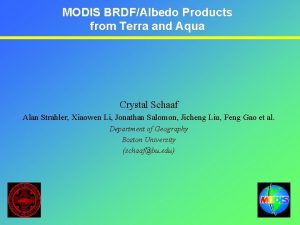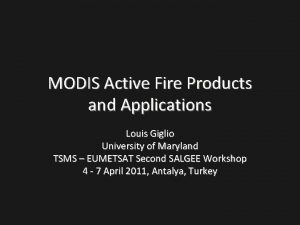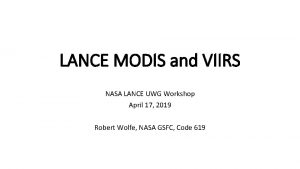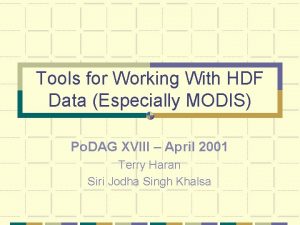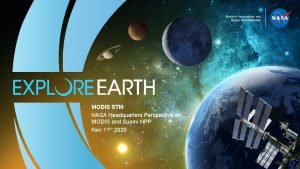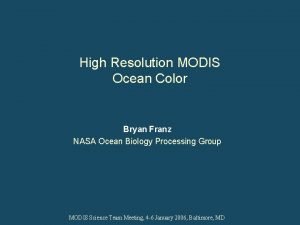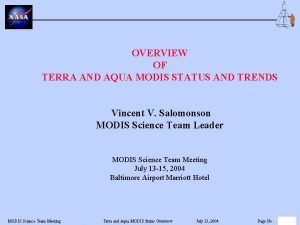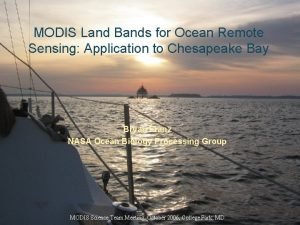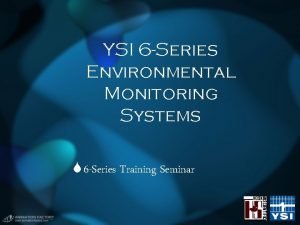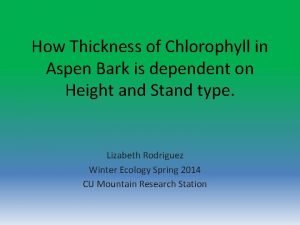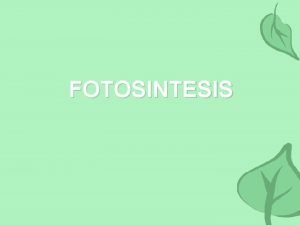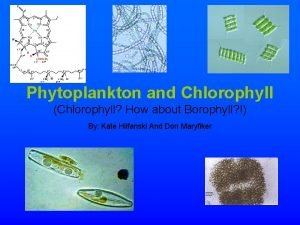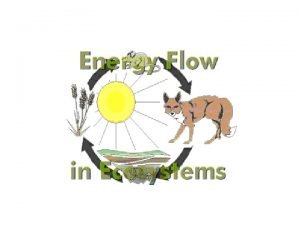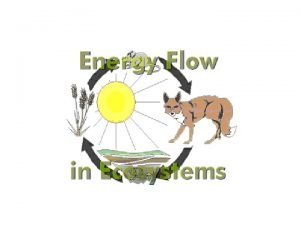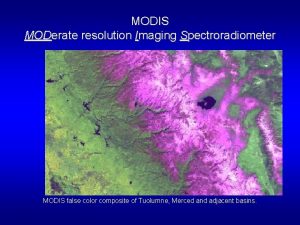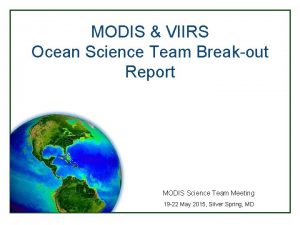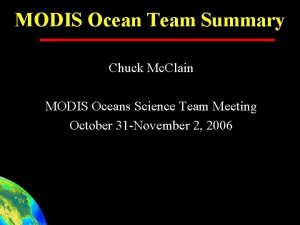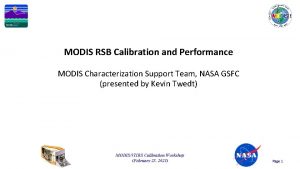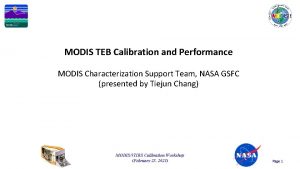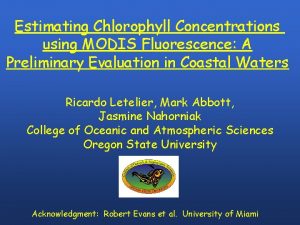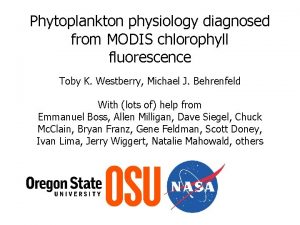Performance of MODIS SemiAnalytic Ocean Color Algorithms Chlorophyll



![Surface map of (a) Temperature (o. C); (b) Nitrate concentration (µM l-1); (c) [chla] Surface map of (a) Temperature (o. C); (b) Nitrate concentration (µM l-1); (c) [chla]](https://slidetodoc.com/presentation_image/f1f75e00ed23d1391c7ff3e5965d5257/image-4.jpg)
















- Slides: 20

‘Performance of MODIS Semi-Analytic Ocean Color Algorithms: Chlorophyll a, Absorption Coefficients, and Absorbed Radiation by Phytoplankton’ by Kendall L. Carder • Absorption coefficients for phytoplankton, aφ(λ), colored dissolved organic matter (CDOM) or gelbstoff, ag(λ), and total, at(λ) • Chlorophyll a (Chlor_a_3) in the presence of CDOM • Instantaneous photosynthetically active radiation for fluorescence, IPAR • Absorbed radiation by phytoplankton for fluorescence, ARP • Parameter adjustment for bio-optical domains comparing SST with NDTs • Near-term focus is on the significantly improved performance of Chlor_a_3 at high latitudes

Absorption spectra for water, CDOM, and phytoplankton

a (443)/a (675) versus a (675) from Bering Sea (MF 0796) and Antarctic Polar Frontal Zone (REV 9802) are compared with high-light tropical and subtropical data (dashed line)
![Surface map of a Temperature o C b Nitrate concentration µM l1 c chla Surface map of (a) Temperature (o. C); (b) Nitrate concentration (µM l-1); (c) [chla]](https://slidetodoc.com/presentation_image/f1f75e00ed23d1391c7ff3e5965d5257/image-4.jpg)
Surface map of (a) Temperature (o. C); (b) Nitrate concentration (µM l-1); (c) [chla] (mg m-3); and (d) a (443)/a (675) for the California upwelling region (Cal 9704) in April 1997.

Blending scheme to transition between fully packaged and unpackaged pigment parameterization for waters with SST between NDT-1 and NDT+4 degrees C [NDT map from D. Kamekowski]

Performance of new blending scheme for waters of the Southern California Bight transitioning between cold, nutrient-rich upwelled waters and offshore, nutrient-poor waters.

Comparison between Chlor_a_3 SA and OC 4 v 4 algorithms for Chlorophyll a for the Southern California Bight

Chlor_a_3 applied to the Arctic region (a). Quantile plot (b) shows no bias. CZCS algorithm, dashed line in (d), shows bias due to package effect

Chlor_a_3 SA algorithm performance versus OC 4 v 4 for Antarctic based on 971 field data points. Note the large negative bias in the OC 4 v 4 quantile plot

Chlor_a_3 semi-analytical retrievals of chlorophyll a for November 2000

Chlor_a_2 empirical (OC 4 surrogate) retrievals of chlorophyll a for November 2000

Semi-analytical retrieval of absorption by CDOM or gelbstoff for November 2000 Note the high values in northern (river-rich) hemisphere

Global histograms of chlorophyll a retrievals for November 2000 using a) empirical Chlor_a_2 and b) semi-analytic Chlor_a_3 algorithms. Mean values are 0. 215 and 0. 325 mg m-3, respectively. Gregg & Conkright (2002)autumn mean = 0. 31 mg m-3.


Match-up Data Sets (preliminary) Provided by the SIMBIOS for Non-Shallow Depths • • Slope: Intercept: r 2 Bias RMS error Linear error Chlor_a_3 Chlor_a_2 0. 97 -. 0045 0. 79 0. 009 0. 173 49. 1% 0. 79 -0. 012 0. 79 -0. 055 0. 190 55. 0%

Striping in the Chlor_a_3 products for the western Gulf of Mexico due to stripes in the Lw values: (left) raw and (right) filtered

Raw and filtered data from scene center. Lines 0, 20, 40, … were each averaged horizontally and then averaged together. Similar steps were taken with Lines 1, 21, 41, etc. until a 20 -line pattern due to striping was acquired

Noise pattern due to vertical striping from left part of GOM scene (solid). A filter was made by ratioing the mean to each line element and applying to each appropriate line by multiplying. Dashed line is the result. Over-compensation occurred since striping was worse in the lower left than in the upper right portions of original scene.

Change in horizontal variance was about 1% as a result of applying the vertical filter. Note solid and dashed lines represent unfiltered and filtered data.

Conclusions • Chlor_a_3 algorithm performance has improved for high-latitude and upwelling scenes with little or no bias. • Sea. Wi. FS OC-4 algorithm performance in the Southern Ocean for field radiance is biased low by >40%; Chlor_a_2 global mean for November 2000 was 0. 215 mg/m 3, while Chlor_a_3 value was 0. 32 mg/m 3. Gregg & Conkright (2002) mean global autumn value was 0. 305 mg/m 3. • Global ocean primary production calculated with the MODIS Terra Chlor_a_3 algorithm are expected to show an increase over Sea. Wi. FSbased values of about 29% for austral spring data. • Preliminary non-shallow match-up field data for Terra Chlor_a_3 and Chlor_a_2 results show errors of 49% and 55%, respectively, with 1% and – 13. 5% linear biases, respectively, with most difference occurring for winter California Current data. • A de-striping approach appears promising if smaller sub-scenes are used in the filter generation and application
 Modis competence center
Modis competence center Modis
Modis Lance modis
Lance modis Hdf tools
Hdf tools Stm nasa
Stm nasa Modis
Modis Aqua terra modis
Aqua terra modis Modis bands
Modis bands Convergent ocean to ocean
Convergent ocean to ocean Ocean ocean convergent boundary
Ocean ocean convergent boundary Convergent boundary
Convergent boundary Ocean ocean convergent boundary
Ocean ocean convergent boundary Chapter 15 ocean water and ocean life answer key
Chapter 15 ocean water and ocean life answer key Sciencechannel.com/activate
Sciencechannel.com/activate Convergent oceanic oceanic plate boundary
Convergent oceanic oceanic plate boundary Blue ocean strategi
Blue ocean strategi Ysi 600 oms
Ysi 600 oms Algae are chlorophyll bearing
Algae are chlorophyll bearing Aspen chlorophyll
Aspen chlorophyll Tempat fotosintesis
Tempat fotosintesis Photosynthesis takes place in
Photosynthesis takes place in
